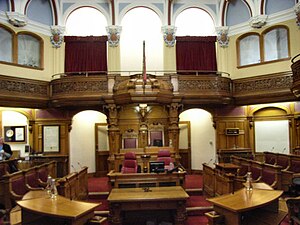League of Nations Security Council
This article is a work-in-progress because it is incomplete and pending further input from an author. Note: The contents of this article are not considered canonical and may be inaccurate. Please comment on this article's talk page to share your input, comments and questions. |
The League of Nations Security Council (LoNSC) is one of four parts of the League of Nations and is charged with ensuring international peace and security. Its powers include establishing peacekeeping operations, enacting international sanctions, and authorizing military action. The LoNSC is the only UN body with the authority to issue binding resolutions on member states.
League of Nations Security Council | |
|---|---|
 Flag of the LoN Security Council | |
| Type | |
| Type | International congress of the League of Nations |
| Leadership | |
Rotating Chairman | Kiravia (for 2022) |
| Structure | |
| Seats | Three permanent members Four annual rotating members |
Length of term | 1 year |
| Meeting place | |
 | |
| Security Council Chamber, Palace of Nations, Alba Concordia | |
History
Role
Members
Permanent members
Rotating members
Chairman
Peacekeeping operations
Demining Operations
Standing Mine Countermeasures Task Group 1
Standing Mine Countermeasures Task Group 1 (SMCTG 1) was formed by League of Nations Security Council Resolution XX in 1975 to demine the high traffic waterways between Levantia and Sarpedon which had been heavily mined during the Firth and Second Great Wars. The current composition is primarily made up of a detachment from the Levantine Union Defence Council, Task Group Gemini, but includes mine hunters from Pelaxia and Stenza. It was also the inspiration for a smaller joint mission by Burgundie and Stenza to demine their maritime boundary due to the Sudmoll island conflicts, started in 2026.